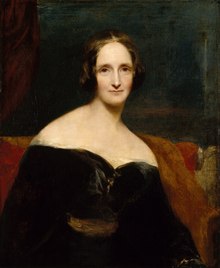
Back Mary Shelley Afrikaans Mary Shelley AN ماري شيلي Arabic مارى شيلى (كاتبه مسرحيه من المملكه المتحده لبريطانيا العظمى و ايرلاندا) ARZ মেৰী শ্বেলী Assamese Mary Shelley AST Meri Şelli Azerbaijani مری شلی AZB Mary Shelley BCL Мэры Шэлі Byelorussian
Mary Shelley | |
|---|---|
 Richard Rothwell's portrait of Shelley was shown at the Royal Academy in 1840, accompanied by lines from Percy Shelley's poem The Revolt of Islam calling her a "child of love and light".[1] | |
| Born | Mary Wollstonecraft Godwin 30 August 1797 London, England |
| Died | 1 February 1851 (aged 53) London, England |
| Occupation | Writer |
| Notable works | Frankenstein (1818), see more... |
| Spouse | |
| Children | 4, including Percy Florence |
| Parents | |
| Relatives |
|
| Signature | |
Mary Wollstonecraft Shelley (UK: /ˈwʊlstənkrɑːft/ WUUL-stən-krahft, US: /-kræft/ -kraft;[2] née Godwin; 30 August 1797 – 1 February 1851) was an English novelist who wrote the Gothic novel Frankenstein; or, The Modern Prometheus (1818), which is considered an early example of science fiction.[3] She also edited and promoted the works of her husband, the Romantic poet and philosopher Percy Bysshe Shelley. Her father was the political philosopher William Godwin and her mother was the philosopher and women's rights advocate Mary Wollstonecraft.
Mary's mother died 11 days after giving birth to her. She was raised by her father, who provided her with a rich informal education, encouraging her to adhere to his own anarchist political theories. When she was four, her father married a neighbour, Mary Jane Clairmont, with whom Mary had a troubled relationship.[4][5]
In 1814, Mary began a romance with one of her father's political followers, Percy Bysshe Shelley, who was already married. Together with her stepsister, Claire Clairmont, she and Percy left for France and travelled through Europe. Upon their return to England, Mary was pregnant with Percy's child. Over the next two years, she and Percy faced ostracism, constant debt and the death of their prematurely born daughter. They married in late 1816, after the suicide of Percy Shelley's wife, Harriet.[6]
In 1816, the couple and Mary's stepsister famously spent a summer with Lord Byron and John William Polidori near Geneva, Switzerland, where Shelley conceived the idea for her novel Frankenstein. The Shelleys left Britain in 1818 for Italy, where their second and third children died before Shelley gave birth to her last and only surviving child, Percy Florence Shelley. In 1822, her husband drowned when his sailboat sank during a storm near Viareggio. A year later, Shelley returned to England and from then on devoted herself to raising her son and her career as a professional author. The last decade of her life was dogged by illness, most likely caused by the brain tumour which killed her at the age of 53.
Until the 1970s, Shelley was known mainly for her efforts to publish her husband's works and for her novel Frankenstein, which remains widely read and has inspired many theatrical and film adaptations. Recent scholarship has yielded a more comprehensive view of Shelley's achievements. Scholars have shown increasing interest in her literary output, particularly in her novels, which include the historical novels Valperga (1823) and Perkin Warbeck (1830), the apocalyptic novel The Last Man (1826) and her final two novels, Lodore (1835) and Falkner (1837). Studies of her lesser-known works, such as the travel book Rambles in Germany and Italy (1844) and the biographical articles for Dionysius Lardner's Cabinet Cyclopaedia (1829–1846), support the growing view that Shelley remained a political radical throughout her life. Shelley's works often argue that cooperation and sympathy, particularly as practised by women in the family, were the ways to reform civil society. This view was a direct challenge to the individualistic Romantic ethos promoted by Percy Shelley and the Enlightenment political theories articulated by her father, William Godwin.
- ^ Seymour, 458.
- ^ "Mary Wollstonecraft". Oxford Learner's Dictionaries. Oxford University Press. Retrieved 12 November 2020.
- ^ Aldiss, Brian (1973). Billion Year Spree: The True History of Science Fiction (first ed.). Doubleday. ISBN 978-0385088879.
- ^ Cite error: The named reference
Letter1814-10-28was invoked but never defined (see the help page). - ^ Cite error: The named reference
StClair295was invoked but never defined (see the help page). - ^ "Shelley's Ghost - Reshaping the image of a literary family". shelleysghost.bodleian.ox.ac.uk. Archived from the original on 8 September 2018. Retrieved 15 December 2024.